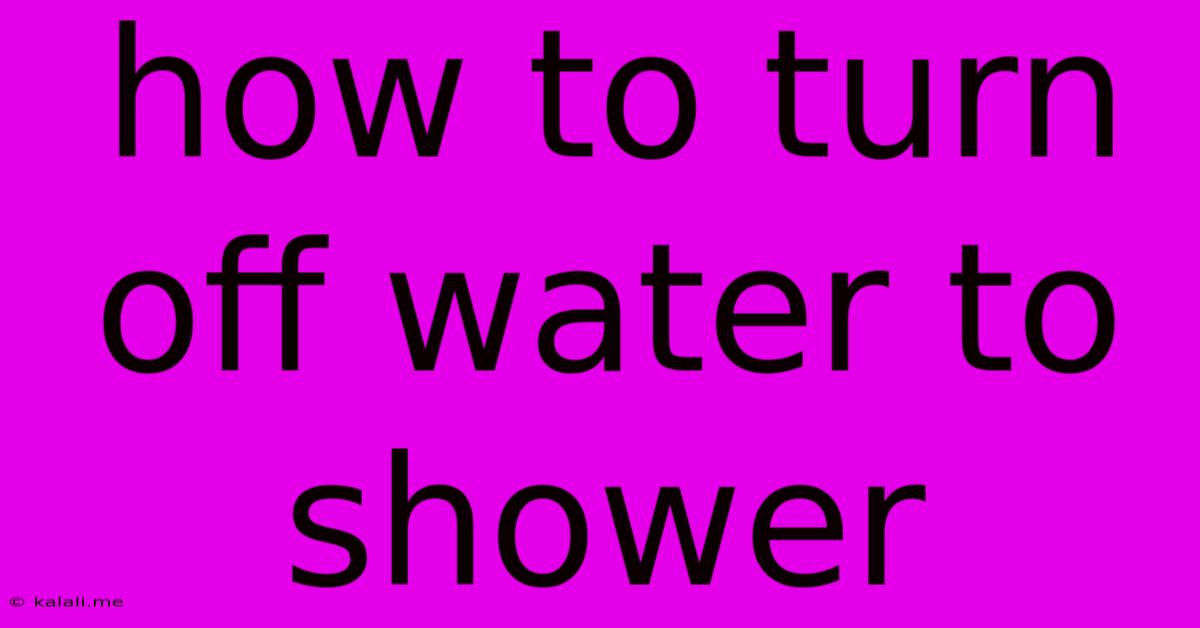How To Turn Off Water To Shower
Kalali
Jun 02, 2025 · 3 min read

Table of Contents
How to Turn Off the Water to Your Shower: A Step-by-Step Guide
Knowing how to turn off the water supply to your shower is crucial for various reasons, from fixing a leaky faucet to preventing water damage during a plumbing emergency. This guide provides a clear, step-by-step process for turning off the water to your shower, covering different scenarios and plumbing setups. Whether you're a seasoned DIY enthusiast or a complete novice, we'll equip you with the knowledge to handle this common household task safely and effectively.
Understanding Your Plumbing System
Before you begin, it's helpful to understand the basic layout of your home's plumbing. Water typically enters your home through a main water shutoff valve, often located near the water meter. From there, it branches out to supply individual fixtures like your shower. The shower's water supply is usually controlled by one or two shut-off valves located either near the shower itself or within the wall.
Locating the Shower's Water Shut-Off Valves
The most common locations for shower shut-off valves are:
- Behind the shower: These valves are often hidden behind access panels in the wall near the shower fixture. You may need a screwdriver to remove the panel.
- Under the sink: If your shower is in a bathroom with a sink, the shut-off valves might be located under the sink cabinet.
- In the basement or utility closet: In some older homes, the shut-off valves for the shower may be located in the basement or a utility closet where the main water lines are.
Step-by-Step Instructions for Turning Off the Water
1. Locate the Shut-Off Valves: This is the most crucial first step. Check the common locations listed above, and look for two valves: one for hot water and one for cold water. They usually have handles that can be turned clockwise or counter-clockwise.
2. Identify the Handle Direction: Observe which way the handle needs to be turned to shut off the water. Most valves turn clockwise to close and counter-clockwise to open. However, it's always best to check before turning any valve. A slight turn to the opposite direction should provide indication. If in doubt, make only a quarter turn to see if water flow is decreasing.
3. Turn Off the Valves Slowly: Gently turn each valve clockwise until the water flow stops completely. Do this slowly to avoid any sudden pressure changes that might damage the pipes. Don't force the valve if it becomes difficult to turn.
4. Check for Water Leakage: After turning off both valves, check for any water leaks around the valves themselves or from the shower head. If you see any leaks, you may need to tighten the valves or contact a plumber.
5. Proceed with your plumbing work: Once the water is successfully turned off, you can proceed with the task that required you to shut off the water in the first place.
Turning the Water Back On
Once you've completed your plumbing work, simply reverse the process by turning each valve counter-clockwise until the water flows freely. Check for leaks again after turning the water back on.
What to Do If You Can't Find the Valves
If you're unable to locate the shut-off valves for your shower, it's best to turn off the main water supply to your house. This is a more drastic measure, but it ensures that no water reaches your shower while you work on any plumbing issues. Remember to turn the main water supply back on once you've finished your work.
This detailed guide empowers you to safely handle water shut-off procedures for your shower. Remember, safety is paramount. If you are uncomfortable performing this task yourself, it's always best to consult a qualified plumber.
Latest Posts
Latest Posts
-
How To Take Out Window Screen
Jun 03, 2025
-
Card Game Hands And Feet Rules
Jun 03, 2025
-
Pull Utility Box Up From Ground
Jun 03, 2025
-
Whatever Is Not Of Faith Is Sin
Jun 03, 2025
-
How To Divide A Wood Panel Into Specific Dimensions
Jun 03, 2025
Related Post
Thank you for visiting our website which covers about How To Turn Off Water To Shower . We hope the information provided has been useful to you. Feel free to contact us if you have any questions or need further assistance. See you next time and don't miss to bookmark.